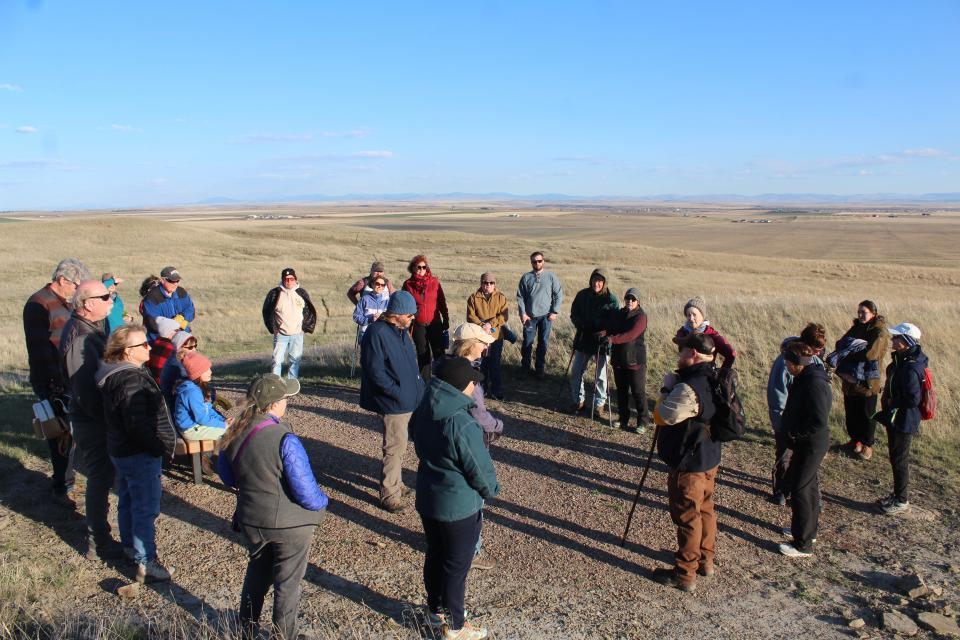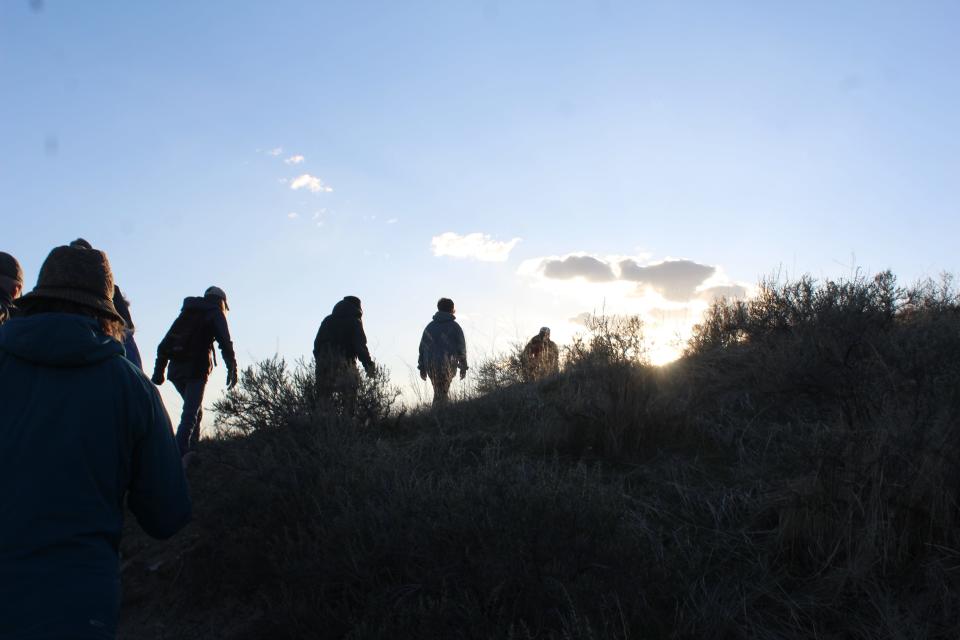Taking in the beauty and history of First People's Buffalo Jump State Park
It was a perfect evening in April, when the long rays of the spring sun finally carried enough warmth to encourage you to shed your heavy winter coat. Across the prairie north of Ulm the song of Western Meadowlarks filled the air. A light breeze carried just enough bite to keep a wool hat on your head.
On Monday, Earth Day, about 25 people gathered at First People’s Buffalo Jump State Park for a guided sunset hike across one of the most important cultural sites in Montana. For at least 800 years the sandstone cliffs that are the focus of the 3,000-acre park sustained hundreds of generations of native peoples, drawn to the high plains just west of Great Falls to harvest the vast buffalo herds.
In the centuries before Spanish ponies escaped and were adopted by the Great Plains tribes, the only way for native peoples to harvest the irreplaceable gift of the buffalo. Thousands of buffalo jumps have been identified across the plains from Texas to Alberta, and Montana to the Mississippi River. Most were only used a handful of times, but because of its size and prime location, the jump north of Ulm was likely used every year for centuries.
“It’s a very spiritual, sacred place for First Peoples,” Park Ranger Andy Keller told the eager hikers. “It’s like going into St. Mark’s or St. Paul’s or any of the great cathedrals in Europe.”
If you’ve never been to First People’s Buffalo Jump it isn’t far away and it isn’t hard to find. Half an hour west of Great Falls and three-and-a-half miles north of Ulm the plains rise and are met by three-miles of rock, 50-feet high, and perfectly sloped so that charging buffalo couldn’t see the drop before it was too late.
The buffalo herds were dense in the lush valleys where the Missouri, Sun, and Smith rivers converge. In July 1806, when explorer Meriwether Lewis passed through the area, he reported seeing a herd of 10,000 buffalo grazing, rolling in the dust, and drinking along a two-mile stretch of the Missouri.
“There are at least 13 different tribes that have oral histories of using this as a buffalo jump,” Keller said. “We had First Peoples from eastern Montana, southern Montana into Wyoming, and as far as eastern Oregon and Washington travel here to use this buffalo jump.”
“Just think about how long it would take you walk with everything you owned in your house in Spokane to get here,” Keller added. “You probably would have been on foot for a month or so just to get here to use this buffalo jump.”

The jump was so important to native sustenance and culture that tribal animosities would be temporarily set aside to honor the sacred site.
“This was traditional Blackfeet territory, but when you got here there could be other people here from a different tribe that you didn’t cooperate with, and you would have to work out your agreements to use this place together,” Keller noted. “This was known as a place of cooperation and peace.”
Radiocarbon dating from an 18-foot layer of accumulated buffalo bone at the base of the cliff suggests the buffalo jump was used between at least 900 A.D. and 1700 A.D. Harvesting the buffalo was a communal effort that took weeks of planning and effort.
“They didn’t just luck upon the buffalo herds,” Keller said. “It took a lot of planning. It took a lot of coordination. It took a lot of knowledge to use these cliffs as a buffalo jump. They were very well thought out planned events. They had generational knowledge passed down for hundreds of generations to give them that information about buffalo.”
Hunts most commonly took place in the late Fall and Winter when the big herds dispersed leaving smaller groupings of 100 or 150 buffalo led by an experienced cow. After days of prayer and preparation the elders of the tribe would select an Ahwa Waki or Buffalo Runner, almost always a young man between the ages of 12 and 18 fleet of foot and brave of heart. Being selected as a Buffalo Runner was a high honor. Upon his shoulders much of the success of the hunt was placed.
The Buffalo Runner would drape himself in a buffalo calf skin, with the skin of the calf’s head concealing his own. He would carry an Iniskim, a small, weathered stone found on the prairie that resembles a buffalo. A true Iniskim would give its possessor power over the buffalo.

Concealed in his disguise the Buffalo Runner maneuvered among the herd and lured the lead cow away by bellowing like a lost calf. It often took days for the Buffalo Runner to draw up the northwest slopes that led to the jump.
As the Buffalo Runner drew the herd ever closer the rest of the tribe built and repaired “drive lines,” mile-long corridors built from rock and mud and hide rope that funneled the oncoming herd into an ever-tightening course toward the deadly cliff.
When the herd had entered sufficiently deep into the driveline, other hunters disguised in wolf skins would tighten around them. Driven by fear, poor eyesight, and the continued calls of the Buffalo Runner, the herd would at first trot and then run as panic set in. People may have leapt out from behind the stone cairns of the driveline, waving blankets and branches to haze the buffalo even farther.
The edge of the cliff is concealed by a low slope. The lead buffalo wouldn’t have recognized the danger until a few dozen feet ahead of it, but even with this warning the oncoming crush of scores of terrified animals pushed the ones ahead of them over the cliff. Crashing to the rocks below many were killed instantly with broken spines and crushed skulls. The injured animals that remained were quickly dispatched by hunters with spears and arrows to finish them off.
At the cliff’s edge the Buffalo Runner would leap onto protected rocky ledge. If he made it time, he would be safe from the horns and hooves, thousands of pounds of terrified animal plunging over the cliff. If he misjudged the Buffalo Runner could be crushed beneath the stampeding head and likely drug down to his death among the sharp rocks below.
This article originally appeared on Great Falls Tribune: Beauty and history at First People's Buffalo Jump State Park

